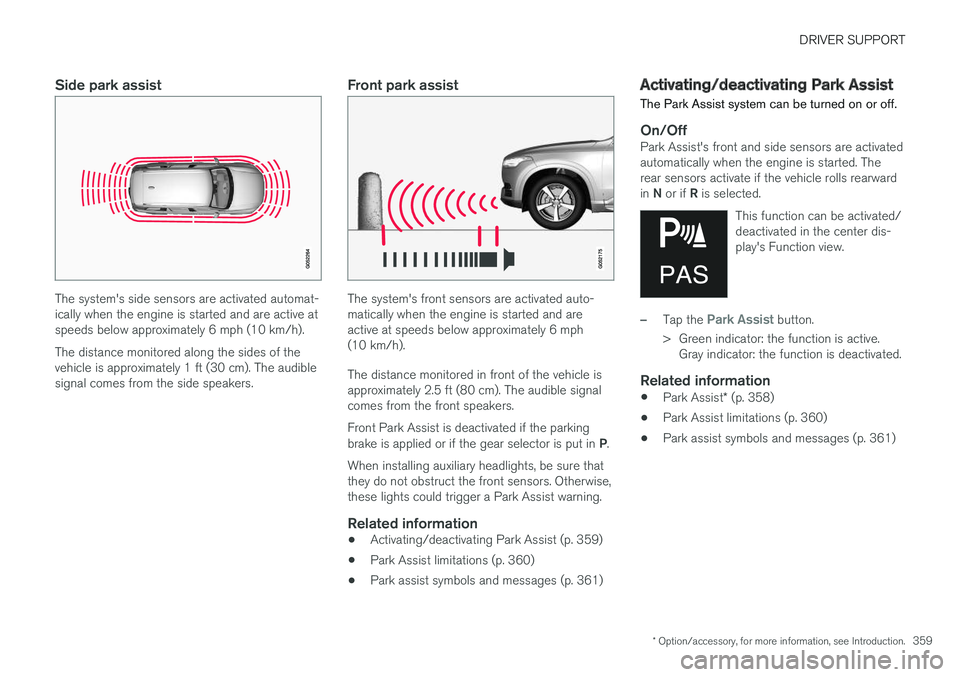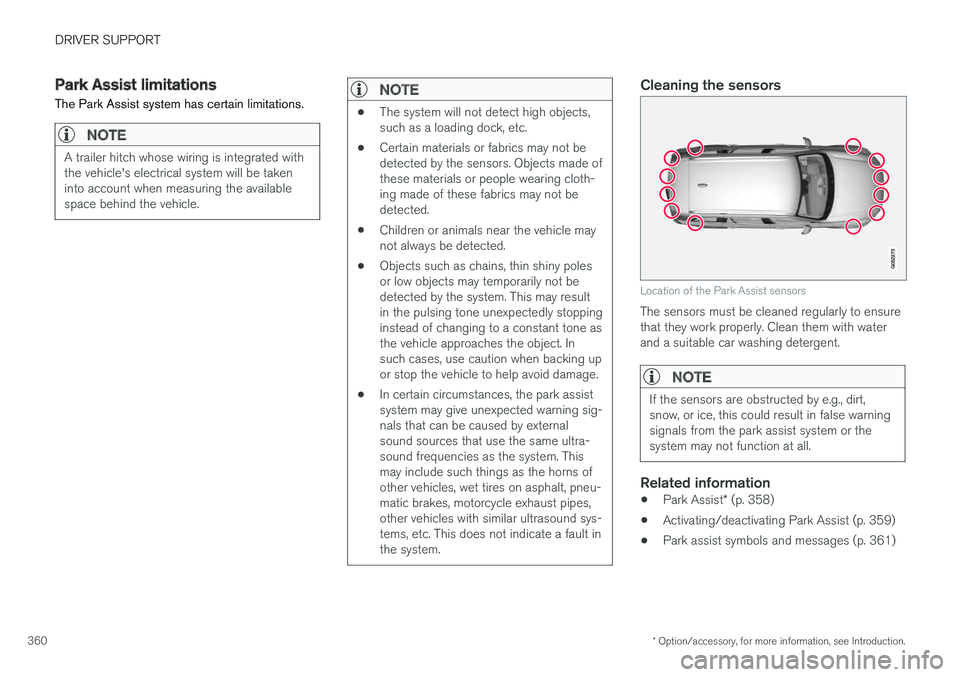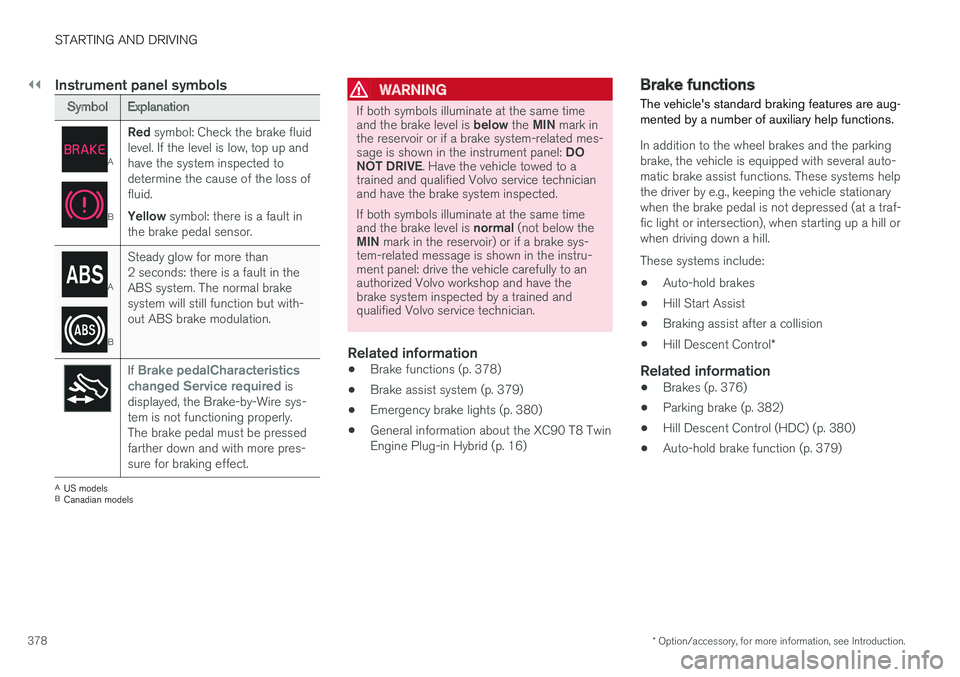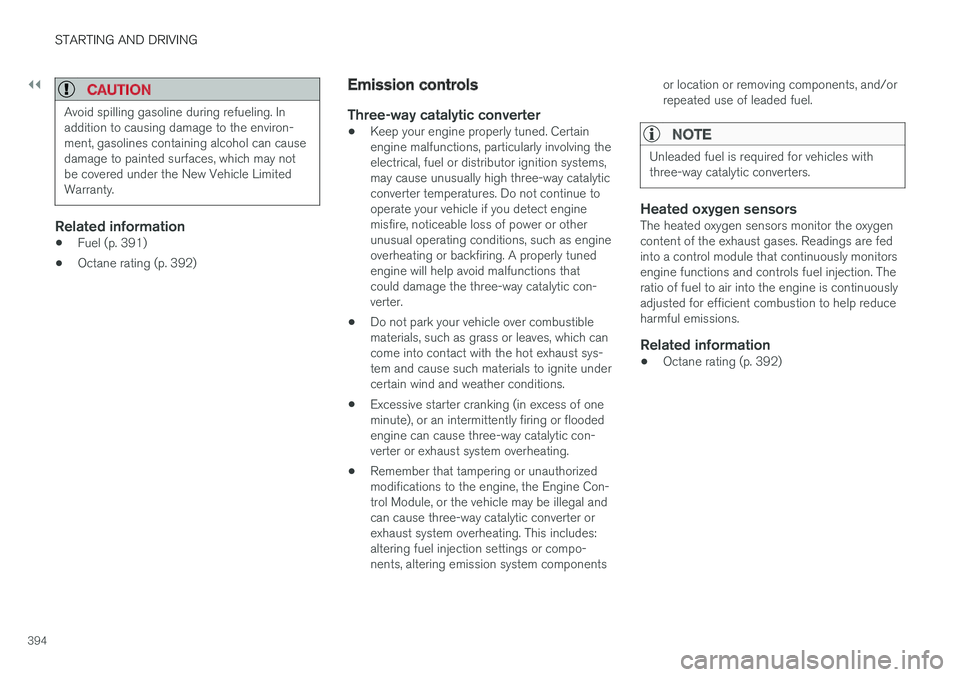sensor VOLVO XC90 TWIN ENGINE HYBRID 2017 Manual Online
[x] Cancel search | Manufacturer: VOLVO, Model Year: 2017, Model line: XC90 TWIN ENGINE HYBRID, Model: VOLVO XC90 TWIN ENGINE HYBRID 2017Pages: 584, PDF Size: 14.2 MB
Page 361 of 584

DRIVER SUPPORT
* Option/accessory, for more information, see Introduction.359
Side park assist
The system's side sensors are activated automat-ically when the engine is started and are active atspeeds below approximately 6 mph (10 km/h).
The distance monitored along the sides of thevehicle is approximately 1 ft (30 cm). The audiblesignal comes from the side speakers.
Front park assist
The system's front sensors are activated auto-matically when the engine is started and areactive at speeds below approximately 6 mph(10 km/h).
The distance monitored in front of the vehicle isapproximately 2.5 ft (80 cm). The audible signalcomes from the front speakers.
Front Park Assist is deactivated if the parkingbrake is applied or if the gear selector is put in P.
When installing auxiliary headlights, be sure thatthey do not obstruct the front sensors. Otherwise,these lights could trigger a Park Assist warning.
Related information
•Activating/deactivating Park Assist (p. 359)
•Park Assist limitations (p. 360)
•Park assist symbols and messages (p. 361)
Activating/deactivating Park Assist
The Park Assist system can be turned on or off.
On/Off
Park Assist's front and side sensors are activatedautomatically when the engine is started. Therear sensors activate if the vehicle rolls rearwardin N or if R is selected.
This function can be activated/deactivated in the center dis-play's Function view.
–Tap the Park Assist button.
>Green indicator: the function is active.Gray indicator: the function is deactivated.
Related information
•Park Assist* (p. 358)
•Park Assist limitations (p. 360)
•Park assist symbols and messages (p. 361)
Page 362 of 584

DRIVER SUPPORT
* Option/accessory, for more information, see Introduction.360
Park Assist limitations
The Park Assist system has certain limitations.
NOTE
A trailer hitch whose wiring is integrated withthe vehicle's electrical system will be takeninto account when measuring the availablespace behind the vehicle.
NOTE
•The system will not detect high objects,such as a loading dock, etc.
•Certain materials or fabrics may not bedetected by the sensors. Objects made ofthese materials or people wearing cloth-ing made of these fabrics may not bedetected.
•Children or animals near the vehicle maynot always be detected.
•Objects such as chains, thin shiny polesor low objects may temporarily not bedetected by the system. This may resultin the pulsing tone unexpectedly stoppinginstead of changing to a constant tone asthe vehicle approaches the object. Insuch cases, use caution when backing upor stop the vehicle to help avoid damage.
•In certain circumstances, the park assistsystem may give unexpected warning sig-nals that can be caused by externalsound sources that use the same ultra-sound frequencies as the system. Thismay include such things as the horns ofother vehicles, wet tires on asphalt, pneu-matic brakes, motorcycle exhaust pipes,other vehicles with similar ultrasound sys-tems, etc. This does not indicate a fault inthe system.
Cleaning the sensors
Location of the Park Assist sensors
The sensors must be cleaned regularly to ensurethat they work properly. Clean them with waterand a suitable car washing detergent.
NOTE
If the sensors are obstructed by e.g., dirt,snow, or ice, this could result in false warningsignals from the park assist system or thesystem may not function at all.
Related information
•Park Assist* (p. 358)
•Activating/deactivating Park Assist (p. 359)
•Park assist symbols and messages (p. 361)
Page 363 of 584

DRIVER SUPPORT
* Option/accessory, for more information, see Introduction.361
Park assist symbols and messages
A number of messages relating to Park Assistwill appear in the instrument panel.
The following table provides some examples.
MessageExplanation
Park Assist System
Unavailable Service required
The system is not functioning properly. Contact a trained and qualified Volvo service technician.
Park Assist System
Sensors blocked, cleaning needed
One or more of the system's sensors are blocked. Check and clean the sensors as soon as possible.
A text message can be erased by briefly pressingthe O button on the right-side steering wheelkeypad. If the message recurs, contact a trainedand authorized Volvo service technician orretailer.
Related information
•Park Assist limitations (p. 360)
•Park Assist* (p. 358)
•Activating/deactivating Park Assist (p. 359)
Page 367 of 584

DRIVER SUPPORT
* Option/accessory, for more information, see Introduction.365
Trajectory lines for a trailer hitch (towbar)
Towbar: activate trajectory lines for a trailerhitch
Zoom: zoom in/out
The camera can help make hitching a trailer eas-ier by showing the "line" that the trailer hitch willtake toward the trailer.
1.Tap Towbar (1).
>The trajectory lines will be displayed andthe trajectory lines for the vehicle will dis-appear.
2.Tap Zoom (2) for a close-up view.
>The camera will zoom in.
Trajectory lines for the trailer hitch and the vehi-cle cannot be shown at the same time.
Front and rear sensor fields
If the vehicle is also equipped with the optionalPark Assist system, this information will be dis-played on the screen as colored field showingthe distance to obstacles that have beendetected.
Front and rear sensors
The screen can display colored sensor fields on the carsymbol at the right
The front and rear fields change colors (yellow-orange-red) as the vehicle moves closer to anobject.
Front/rear field col-orsDistance to the object
Yellow2.0–4.9 ft (0.6–1.5 m )
Orange1.3–2.0 ft (0.4–0.6 m)
Red0–1.3 ft (0–0.4 m)
Side sensors
The side fields will only be shown in orange.
Side field colorDistance to the object
Orange0–1.0 ft (0–0.3 m)
Related information
•Park Assist Camera (PAC)* (p. 362)
•Starting the Park Assist Camera (PAC)*(p. 366)
Page 373 of 584

DRIVER SUPPORT
}}
371
When the vehicle is backing up, PAP will steer itinto the parking space. Do as follows:
1.Check that the area behind the vehicle isclear and put the gear selector in R.
2. Back up slowly without moving the steeringwheel. The vehicle's speed must be belowapproximately 4 mph (7 km/h).
3. Keep an eye on the instrument panel and beprepared to stop the vehicle when you areinstructed by PAP to do so.
NOTE
•Release the wheel while PAP is steeringthe vehicle.
•The steering wheel must be able to turnfreely.
•For PAP to function optimally, wait untilthe steering wheel is no longer turningbefore beginning the next phase of theparking procedure.
3: Adjusting the vehicle's position
Parallel
Perpendicular
After the vehicle has backed into the parkingspace, its position in the space has to be
adjusted by driving slightly forward and backingup.
1.Put the gear selector in D, wait until thesteering wheel has turned and drive forwardslowly.
2.Stop the vehicle when you are instructed byPAP to do so.
3.Put the gear selector in R, back up slowlyand stop when you are instructed by PAP todo so.
When the parking procedure is finished (this willbe indicated by a text message and a graphicimage), PAP switches off automatically. If neces-sary, the driver may need to make minor adjust-ments to ensure that the vehicle is parked cor-rectly.
CAUTION
The warning distance is shorter when PAP isusing the sensors than when Park Assist isusing them.
Leaving a parking space
This function can only be usedfor a vehicle that has been par-allel parked and is activated inthe center display's Functionview.
Page 375 of 584

DRIVER SUPPORT
* Option/accessory, for more information, see Introduction.373
•Heavy rain or snow may inhibit PAP'scapacity to correctly measure a parkingspace.
•Do not use PAP when using snow chainsand/or a temporary spare tire.
•Do not use PAP if there are any objects pro-truding from the vehicle.
WARNING
•The front end of your vehicle may turn outtoward oncoming traffic during the park-ing procedure.
•Objects located above the parking sen-sors' field of vision are not included whenPAP measures a parking space. For thisreason, PAP may turn into the parkingspace too soon. Avoid parking spaces ofthis type.
•The driver is always responsible for deter-mining if PAP has selected a suitableparking space.
Maintenance
Location of the PAP sensors
In order for PAP to function correctly, these sen-sors must be cleaned regularly with water and asuitable car washing detergent.
Related information
•Park Assist Pilot (PAP)* (p. 368)
•Park Assist Pilot (PAP)* limitations (p. 372)
•Park Assist Pilot (PAP)* symbols and mes-sages (p. 374)
Page 376 of 584

DRIVER SUPPORT
* Option/accessory, for more information, see Introduction.374
Park Assist Pilot (PAP)* symbolsand messages
Park Assist Pilot uses graphics and text mes-sages to indicate if there is a problem with thesystem.
Various PAP-related combinations of graphicsand text messages are displayed in the instru-ment panel and sometimes also include suitableactions.
The following table provides some examples.
MessageExplanation
Park Assist System
Unavailable Service required
The system is not functioning properly. Contact a trained and qualified Volvo service technician.
Park Assist System
Sensors blocked, cleaning needed
One or more of the system's sensors are blocked. Check and clean the sensors as soon as possible.
A text message can be erased by briefly pressingthe O button in the center of the right-side steer-ing wheel keypad.
Contact a Volvo retailer or a trained and qualifiedVolvo service technician If a message indicatingthat PAP is not functioning properly remains dis-played or recurs.
Related information
•Park Assist Pilot (PAP)* (p. 368)
•Using Park Assist Pilot (PAP)* (p. 369)
•Park Assist Pilot (PAP)* limitations (p. 372)
Page 380 of 584

||
STARTING AND DRIVING
* Option/accessory, for more information, see Introduction.378
Instrument panel symbols
SymbolExplanation
A
B
Red symbol: Check the brake fluidlevel. If the level is low, top up andhave the system inspected todetermine the cause of the loss offluid.
Yellow symbol: there is a fault inthe brake pedal sensor.
A
B
Steady glow for more than2 seconds: there is a fault in theABS system. The normal brakesystem will still function but with-out ABS brake modulation.
If Brake pedalCharacteristicschanged Service required isdisplayed, the Brake-by-Wire sys-tem is not functioning properly.The brake pedal must be pressedfarther down and with more pres-sure for braking effect.
AUS modelsBCanadian models
WARNING
If both symbols illuminate at the same timeand the brake level is below the MIN mark inthe reservoir or if a brake system-related mes-sage is shown in the instrument panel: DONOT DRIVE. Have the vehicle towed to atrained and qualified Volvo service technicianand have the brake system inspected.
If both symbols illuminate at the same timeand the brake level is normal (not below theMIN mark in the reservoir) or if a brake sys-tem-related message is shown in the instru-ment panel: drive the vehicle carefully to anauthorized Volvo workshop and have thebrake system inspected by a trained andqualified Volvo service technician.
Related information
•Brake functions (p. 378)
•Brake assist system (p. 379)
•Emergency brake lights (p. 380)
•General information about the XC90 T8 TwinEngine Plug-in Hybrid (p. 16)
Brake functions
The vehicle's standard braking features are aug-mented by a number of auxiliary help functions.
In addition to the wheel brakes and the parkingbrake, the vehicle is equipped with several auto-matic brake assist functions. These systems helpthe driver by e.g., keeping the vehicle stationarywhen the brake pedal is not depressed (at a traf-fic light or intersection), when starting up a hill orwhen driving down a hill.
These systems include:
•Auto-hold brakes
•Hill Start Assist
•Braking assist after a collision
•Hill Descent Control*
Related information
•Brakes (p. 376)
•Parking brake (p. 382)
•Hill Descent Control (HDC) (p. 380)
•Auto-hold brake function (p. 379)
Page 393 of 584

STARTING AND DRIVING
391
Fuel
Volvo recommends the use of detergent gaso-line to control engine deposits.
Deposit control gasoline (detergent
additives)
Detergent gasoline is effective in keeping injec-tors and intake valves clean. Consistent use ofdeposit control gasolines will help ensure gooddrivability and fuel economy. If you are not surewhether the gasoline contains deposit controladditives, check with the service station operator.
NOTE
Volvo does not recommend the use of exter-nal fuel injector cleaning systems.
Unleaded fuel
Each Volvo has a three-way catalytic converterand must use only unleaded gasoline. U.S. andCanadian regulations require that pumps deliver-ing unleaded gasoline be labeled "UNLEADED".Only these pumps have nozzles which fit yourvehicle's filler inlet. It is unlawful to dispense lea-ded fuel into a vehicle labeled "unleaded gaso-line only". Leaded gasoline damages the three-way catalytic converter and the heated oxygensensor system. Repeated use of leaded gasolinewill lessen the effectiveness of the emission con-trol system and could result in loss of emissionwarranty coverage. State and local vehicle
inspection programs will make detection of mis-fueling easier, possibly resulting in emission testfailure for misfueled vehicles.
NOTE
Some U.S. and Canadian gasolines contain anoctane enhancing additive called methyl-cyclopentadienyl manganese tricarbonyl(MMT). If such fuels are used, your EmissionControl System performance may be affected,and the Check Engine Light (malfunctionindicator light) located on your instrumentpanel may light. If this occurs, please returnyour vehicle to a trained and qualified Volvoservice technician for service.
Gasoline containing alcohol and ethers,
"Oxygenated fuels"
Some fuel suppliers sell gasoline containing"oxygenates" which are usually alcohols orethers. In some areas, state or local laws requirethat the service pump be marked indicating useof alcohols or ethers. However, there are areas inwhich the pumps are unmarked. If you are notsure whether there is alcohol or ethers in thegasoline you buy, check with the service stationoperator. To meet seasonal air quality standards,some areas require the use of "oxygenated" fuel.
Volvo allows the use of the following "oxygen-ated" fuels; however, the octane ratings listedmust still be met.
Alcohol – Ethanol
Fuels containing up to 10% ethanol by volumemay be used. Ethanol may also be referred to asEthyl alcohol, or "Gasohol".
Ethers – MTBE: Fuels containing up to15% MTBE may be used.
Methanol
Do not use gasolines containing methanol(methyl alcohol, wood alcohol). This practice canresult in vehicle performance deterioration andcan damage critical parts in the fuel system. Suchdamage may not be covered under the NewVehicle Limited Warranty.
Related information
•Octane rating (p. 392)
•Opening/closing the fuel filler door (p. 393)
Page 396 of 584

||
STARTING AND DRIVING
394
CAUTION
Avoid spilling gasoline during refueling. Inaddition to causing damage to the environ-ment, gasolines containing alcohol can causedamage to painted surfaces, which may notbe covered under the New Vehicle LimitedWarranty.
Related information
•Fuel (p. 391)
•Octane rating (p. 392)
Emission controls
Three-way catalytic converter
•Keep your engine properly tuned. Certainengine malfunctions, particularly involving theelectrical, fuel or distributor ignition systems,may cause unusually high three-way catalyticconverter temperatures. Do not continue tooperate your vehicle if you detect enginemisfire, noticeable loss of power or otherunusual operating conditions, such as engineoverheating or backfiring. A properly tunedengine will help avoid malfunctions thatcould damage the three-way catalytic con-verter.
•Do not park your vehicle over combustiblematerials, such as grass or leaves, which cancome into contact with the hot exhaust sys-tem and cause such materials to ignite undercertain wind and weather conditions.
•Excessive starter cranking (in excess of oneminute), or an intermittently firing or floodedengine can cause three-way catalytic con-verter or exhaust system overheating.
•Remember that tampering or unauthorizedmodifications to the engine, the Engine Con-trol Module, or the vehicle may be illegal andcan cause three-way catalytic converter orexhaust system overheating. This includes:altering fuel injection settings or compo-nents, altering emission system components
or location or removing components, and/orrepeated use of leaded fuel.
NOTE
Unleaded fuel is required for vehicles withthree-way catalytic converters.
Heated oxygen sensors
The heated oxygen sensors monitor the oxygencontent of the exhaust gases. Readings are fedinto a control module that continuously monitorsengine functions and controls fuel injection. Theratio of fuel to air into the engine is continuouslyadjusted for efficient combustion to help reduceharmful emissions.
Related information
•Octane rating (p. 392)